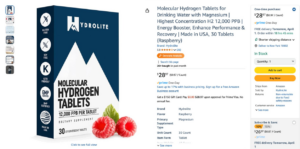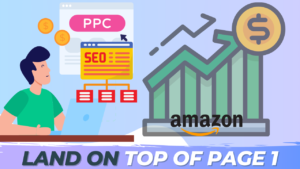
Introduction
Never advertised on Amazon before? Don’t panic! In this article, I’ve laid out the basics of Amazon PPC bidding process for absolute newbies. A quick guide for beginners, if you must. Having a great-value product with massive potential in the market is one thing. Advertising and converting it on a huge e-commerce platform like Amazon is another. When building a brand on Amazon, getting your A-game to the table is paramount above else. But remember, creating a profitable business on Amazon involves several elements that need to come together. Amazon advertising is one of them.
Before launching your first campaign, it’s essential to understand how campaign bidding works for Sponsored Products Ads.
But first…
What is PPC?
Amazon Pay-per-Click (PPC) advertising is an auction-based system that allows advertisers to bid on keywords and pay for traffic. Every time an Amazon customer searches and clicks on a specific product, the seller with the highest bid on the relevant keywords wins the product ad placement.
Think about it this way. When you list a new product on Amazon, one of the first things to accomplish is to get your product to appear in the searches of millions of potential shoppers.
In a nutshell, PPC optimization is a series of specific processes to improve Amazon advertising performances. The method includes an optimization cycle to measure, analyze, test, and execute your Amazon advertising strategies.
Knowing your Amazon Metrics
Here are some essential PPC metrics that you should know:
Impressions
A figure that shows the number of times an advertised product appeared or was shown on the Amazon search result page, whether or not the prospective buyer clicked on it.
Top-of-Search IS
Top-of-Search Impression Share measures the percentage of total first-page searches you could get. Available for Sponsored Brands and Sponsored Products campaigns.
Clicks
The number of times an Amazon shopper clicks on your advertisement.
CTR
Click-through rate estimates the relevance of your listing attributed to the keyword. Calculated as clicks/impressions.
Spend
The total cost for all clicks. When creating campaigns, Spend is set as a budget then Amazon will promote the ad until the budget is used up.
CPC
Cost per Click is calculated as cost over clicks (cost/click). More competitive keywords will have a higher CPC.
Sales
Sales is the total value of products sold to shoppers within the specified timeframe for a type of campaign due to clicks on your ads. Note that you can also drive sales from items other than what was advertised.
Orders
The total number of Amazon orders shoppers placed after clicking on your ad.
ACOS
The Advertising Cost of Sales metric shows the percentage of your sales that you’ve spent on advertising.
ROAS
Stands for Return of Advertising Spend. The revenue you receive from your advertising investment is calculated as revenue over ad spend (revenue/spend).
Conversion Rate
Measures the efficacy of your PPC and is calculated after dividing total Orders by total Clicks (orders/clicks).
How does Amazon’s PPC auction work?

There’s no denying how a well-optimized PPC campaign can remarkably improve your product’s discoverability in search rankings for the keywords you select.
Amazon PPC, sometimes referred to as “sponsored ads,” is an advertising platform that helps sellers boost their online product sales by leveraging relevant keywords.
Note that when running PPC ads, you are not paying for impressions. You will only pay Amazon each time your ad gets a click. Hence, you PAY per CLICK.
In the Cost-per-Click model for Sponsored Product ads, Amazon offers the selling of goods or services for purchase by bid. Bidders (advertisers) place bids against each other to win the opportunity to get their ad placed on display for shoppers. Amazon will run a real-time auction to decide which ads will appear for each relevant search term or query when a potential customer searches for products. It will also determine the order of the ads that will appear on the page. When a customer clicks an ad for a particular product and buys it within a week or two, the sale of the product will be credited to that click. You will set your own bid amounts for each Sponsored Product ad campaign you create. To help you make informed decisions, Amazon will recommend suggested bids and provide suggested bid ranges. You see, Amazon uses a Dynamic bidding system that helps improve campaign performances automatically and in real-time. This type of system allows Amazon predict the likelihood of a click converting to a sale whenever a Sponsored Product ad is eligible to appear.
3 types of Amazon bidding strategies:

Amazon gives us a detailed description of how bidding works on Sponsored Products here.
a. Dynamic bidding – up and down
A bid can fluctuate up or down depending on the likelihood of conversion. Amazon may increase the bid up to 100% if the conversion is high and may decrease the bid by 100% when the possibility of conversion is low.
b. Dynamic bidding – down only
A bid can only fluctuate downward when the possibility of conversion is low. This is a great place to start for ad campaign beginners. Not only does it optimize ad spending in cases where ads are not converting, but it may also help reduce ad costs.
c. Fixed bidding
The bid you choose will be set as default and will remain the same whether conversions are high or low.
Amazon selects and ranks eligible ads by evaluating the target-level bid and the relevancy to the matched search/query. This means that the auction winner may not necessarily need to bid the highest to win the top ad placement as relevance can introduce a factor for discount.
Cost-per-click auctions usually follow standard Second-Price Auction rules. The highest bidder only pays $0.01 more than the second-highest bidder.
Let’s say the highest bidder bids $2 for a keyword. The next highest bidder will have a default bid of $1.50. The highest bidder wins the ad placement but will only pay $1.51 instead of $2 because a bidder will only have to pay $0.01 more than the other bidder.
Pro tip: Choose the bidding strategy and bid amounts that work best for your budget and goals.

Infographics from: Amazon
After running your campaign for at least 2 weeks, review its performance data from the Campaign Manager.
This is when you can adjust your bids, budget, and bidding strategy to continually optimize the performance of your campaign. Always let your campaign run for at least 2 weeks before making any changes. Remember that sales attribution may happen within two weeks after shoppers click your ad.
The two-week rule will ensure you accurately reflect your campaign’s results in the Campaign Manager.
Stepping Up Your PPC Game
Things continue to evolve for both sellers and shoppers in the competitive world of Amazon. In 2021, Amazon’s advertising revenue contribution went up 2x as large as Snap, Twitter, Roku, and Pinterest combined.
Most sellers are accustomed to focusing on rebates, getting 5-star reviews, and implementing PPC campaigns to rank their products. But now, we see a shift in the way sellers traditionally build their brands on the platform. It takes more than just implementing standard strategies to become profitable on Amazon today. We need to constantly level up our PPC game as sellers to gain profitable long-term returns.
This is why elevating your skills in Amazon marketing is ever so important. As a highly competitive industry beginner, you must always stay on the lookout for best practices and continuously hone your PPC strategies. For more PPC tips, check out How to Set Up Amazon PPC Campaigns for Product Launch.
References:
https://advertising.amazon.com/library/videos/campaign-bidding-sponsored-products
https://bowtiedamazon.substack.com/p/intro-to-amazon-ppc-basics-of-ppc?s=r






